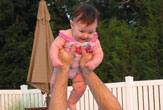Study: How to Give Music Lessons to Babies

If you want your baby to be a country star, bounce it to the two-step right off the bat. If a waltz is more your preference, then rock it to sleep on every third beat.
A new study finds that hearing and feeling different beats is an early step in a baby's appreciation and perception of music.
The research was designed to test how the infant brain processes auditory information. Sixteen babies at seven months heard an ambiguous rhythm pattern with no accented beats. Adults bounced half the infants on every second beat, in a march-like rhythm, as in ONE-two-ONE-two-ONE-two. The other half were bounced on every third beat, in a waltz-like ONE-two-three-ONE-two-three.
Then the infants heard rhythm patterns with accented beats, but without the bouncing. Those who had previously been waltzing listened longer to the waltz in Round 2, and the babies that had been marched preferred the march.
The study was done by Jessica Phillips-Silver and Laurel J. Trainor at McMaster University in Canada and is reported in today's issue of the journal Science.
The results "provide evidence that the experience of body movement plays an important role in musical rhythm perception," the authors write.
"The simultaneous experience of listening and moving to a rhythm wires the brain so that different senses work together," said Trainor, a psychology professor. "Our interpretation of sound is affected not only by our auditory system but by input from our other senses as well."
Sign up for the Live Science daily newsletter now
Get the world’s most fascinating discoveries delivered straight to your inbox.
The point for parents:
"For the first time, we are able to show that this experience not only affects their emotional state, but also influences infants' sensory development," said Phillips-Silver.
Related Stories
Robert is an independent health and science journalist and writer based in Phoenix, Arizona. He is a former editor-in-chief of Live Science with over 20 years of experience as a reporter and editor. He has worked on websites such as Space.com and Tom's Guide, and is a contributor on Medium, covering how we age and how to optimize the mind and body through time. He has a journalism degree from Humboldt State University in California.











